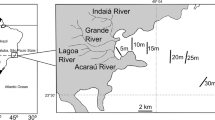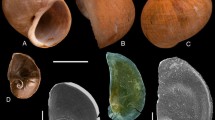Abstract
We studied reproduction and larval development in three species of pedunculated barnacles with different depth distribution, that is, Scalpellum scalpellum (30–200 m), Ornatoscalpellum stroemii (100–1,600 m) and Arcoscalpellum michelottianum (64–5,190 m). Morphology, position and number of males in the female/hermaphrodite, type of larval development and the number and size of eggs were recorded. All three species have a pair of pocket-like receptacles, each of which can host only a single male in O. stroemii, up to five males in S. scalpellum and up to 12 males in A. michelottianum. Eggs and larvae were smallest in S. scalpellum, intermediately sized in O. stroemii and largest in A. michelottianum. Brood size was comparable for S. scalpellum and O. stroemii, but five times higher in A. michelottianum. The ratio for body/egg size is almost similar in S. scalpellum and A. michelottianum, but much smaller in O. stroemii. Both S. scalpellum and A. michelottianum have nauplii that spend upwards of 10 days in the plankton while the larvae of O. stroemii hatch as cyprids that settle soon after release. All these reproductive data indicate that O. stroemii invests considerably more in each propagule than the other two species. We hypothesize that the observed differences in reproductive system and mode of development in the three species represent adaptations to their different habitats. S. scalpellum are mainly transported by currents in the coastal sublittoral zone. O. stroemii is presumably spread by intermediate deep currents along the shelf and shelf-slope, while A. michelottianum occurs on seamounts and is probably transported by demersal currents over wide areas of inhospitable soft-bottoms. Our observations are in accordance with the general pattern that, egg-size and propagule-size are positively correlated to bathymetric and geographic distribution, and that the continental slope environment represents a high disturbance environment, where a short larval stage is an advantage.








Similar content being viewed by others
References
Anderson DT (1994) Barnacle structure, function, development and evolution. London, Chapman & Hall, pp 1–357
Barnard KH (1924) Contributions to the crustacean fauna of South Africa, Nr 7, Cirripedia. Ann S Afr Mus 20:1–103
Barnes M (1989) Egg production in cirripedes. Oceanogr Mar Biol Annu Rev 27:91–166
Blomsterberg M, Høeg JT, Jeffries WB, Lagersson NC (2004). Antennulary sensory organs in cyprids of Octolasmis angulata and three Species of Lepas (Crustacea: Thecostraca: Cirripedia: Thoracica): a Scanning Electron Microscopy Study. J Morphol 200:141–153
Bocquet-Védrine J (1972) Conditions écologiques nécessaires a l’instauration du parasitisme de Cirripèdes Operculés par les Rhizocéphales. C R Acad Sci, Paris 275D:67–69
Buhl-Mortensen L, Mortensen PB (2004) Crustacean fauna associated with the deep-water corals Paragorgia arborea and Primnoa resedaeformis. J Nat Hist 38:1233–1247
Buhl-Mortensen L, Mortensen PB (2005) Distribution and diversity of species associated with deep-sea gorgonian corals off Atlantic Canada. In: Freiwald A, Roberts JM (eds) Cold-water corals and ecosystems, Springer-Verlag, Berlin Heidelberg New York, pp 849–879
Charnov EL (1987) Sexuality and hermaphroditism in barnacles: a natural selection approach. In: Southward AJ (ed) Barnacle biology, Crustacean Issues, pp 809–105
Crisp DJ (1983) Chelonobia patula (Ranzani), a pointer to the evolution of the complimental male. Mar Biol Lett 4:281–294
Darwin C (1851) A monograph on the subclass Cirripedia.,vol 1. The Lepadidae. Ray Soc, London, p 400
Etter RJ, Rex MA (1990) Population differentiation decreases with depth in deep-sea gastropods. Deep-Sea Res 37:1251–1261
Gage JD (1994) Recruitment ecology and age structure of deep-sea invertebrate populations. In: Young CM, Eckelbarger KJ (eds) Reproduction, larval biology, and recruitment of the deep-sea benthos. Columbia University Press, New York, pp 233–242
Grassle J, Sanders H, Hessler R, Rowe G, McLellan (1975) Pattern and zonation: a study of the bathyal megafauna using the research submersible Alvin. Deep-Sea Rese 13:5–262
Grassle JF, Sanders HL, Smith WK (1979) Faunal changes with depth in the deep sea benthos. Ambio Spe Rep 6:47–50
Hoek PPC (1884) Report on the Cirripedia: anatomical part. Rep. Challenger Expedition, Zool 10(3):1–47
Høeg JT (1984) Size and settling behaviour in male and female cypris larvae of the parasitic barnacle Sacculina carcini Thompson (Crustacea: Cirripedia: Rhizocephala). J Exp Mar Biol Ecol 76:145–156
Høeg JT (1991) Functional and evolutionary aspects of the sexual system in the Rhizocephala (Thecostraca: Cirripedia). In: Bauer RT, Martin JW (eds) Crustacean sexual Biology. Columbia University Press, New York, pp 208–227
Høeg JT (1995) The biology and life cycle of the Cirripedia Rhizocephala. J Mar Biol Assoc UK 75:517–550
Høeg JT, Lützen J (1995) Life cycle and reproduction in the Cirripedia Rhizocephala. Oceanogr Mar Biol Annu Rev 33:427–485
Høeg JT, Ritchie LE (1987) Correlation between cypris age, settlement rate and anatomical developmentin Lernaeodiscus porcellanae (Cirripedia: Rhizocephala). J Mar Biol Assoc UK 67:65–75
Høeg JT, Glenner H, Shields J (2005) Cirripedia Thoracica and Rhizocephala (barnacles). In: Rohde K (ed) Marine parasites. CABI Publishing, Wallingford UK and CSIRO Publishing, Collingwood, Victoria, Australia pp 154–165
Høeg JT, Lagersson NC, Glenner H (2003) The complete cypris larva and its significance in thecostracan phylogeny. In: Scholtz G (ed). Evolutionary and developmental biology of Crustacea. Crustacean issues 15. A.A. Balkema/Lisse, Abingdon, Exton (PA) & Tokyo, pp197–215
Høeg JT, Kapel CM, Thor P, Webster P (1990) The anatomy and sexual biology of Boschmaella japonica, an akentrogonid rhizocephalan parasite on barnacles from Japan (Crustacea: Cirripedia: Rhizocephala). Acta Zool 71:177–188
Kaufmann R (1965) Zur Embryonal- und Larvalentwicklung von Scalpellum scalpellum L. (Crust. Cirr.). Z Morph Ökol Tiere 55:161–232
Klepal W (1987) A review of the comparative anatomy of the males in cirripedes. Oceanogr Mar Biol Ann Rev 25:285–351
Klepal W, Nemeschkal HL (1995) Cuticular structures in the males of Scalpellidae (Cirripedia Thoracica): a character analysis. In: Schram FR, Hoeg JT (eds) New frontiers in barnacle evolution. Crustacean Issues 10:179–207
Krüger P (1922) Die Embryonalentwicklung von Scalpellum scalpellum L. I. Furchung und Anlage der Keimblätter. Arch mikr Anat 96:355–386
MaxIlvaine JC, Ross DA (1979) Sedimentary processes on the continental slope of New England. J Sedimentary Petrol 49:563–574
Morato T, Pauly D (2004) Seamounts: biodiversity and fisheries. Fisheries Centre Res Rep 12(5):78
Moyse J (1987) Larvae of lepadomorph barnacles. In: Southward AJ (ed) Barnacle biology. Crustacean issues 5:329–362
Newman WA (1980) A review of extant Scillaelepas (Cirripedia: Scalpellidae) including recognition of new species from the North Atlantic, Western Indian Ocean and New Zealand. Tethys 9:379–398
Nilsson-Cantell C-A (1931) Cirripeds from the Indian Ocean and Malay Archipelago in the Brittish Museum (Nat. Hist.). London Ark Zool 23A(18):1–12
Nilsson-Cantell C-A (1978) Cirripedia Thoracica and Acrothoracica. Universitetsforlaget, Oslo, p 133
Rex MA (1977) Zonation in deep-sea gastropods: the importance of biological interactions to rates of zonation. Eur Symp Mar Biol 11:521–530
Rex MA (1983) Geographic patterns of species diversity in the deep-sea benthos. The sea. Wiley, New York
Rex MA, Warén A (1982) Planktotrophic development in deep-sea prosobranch snails from the western North Atlantic. Deep-Sea Res 29:171–184
Rowe G (1971) Observations on bottom currents and epibenthic populations in Hatteras Submarine Canyons. Deep-Sea Res 18:569–581
Scheltema R (1994) Adaptation for reproduction among deep-sea benthic molluscs: an appraisal of existing evidence. In: Young CM, Eckelbarger KJ (eds) Reproduction, larval biology, and recruitment of the deep-sea benthos. Columbia University Press, New York, pp 45–75
Scholtz G (2000) Evolution of the nauplius stage in malacostracan crustaceans. J Zool Syst Evol Res 38(3):175–187
Southward AJ, Jones D (2003) A revision of stalked barnacles (Cirripedia: Thoracica: Scalpellomorpha: Eolepadidae: Neolepadinae) associated with hydrothermalism, including a description of a new genus and species from a volcanic seamount off Papua-New Guinea. Senckenbergiana Maritima 32:77–93
Strathmann RR (1993) Hypotheses on the origin of marine larvae. Annu Rev Ecol Syst 24:89–118
Svane I (1986) Sex determination in Scalpellum scalpellum (Cirripedia: Thoracica: Lepadomorpha), a hermaphroditic goose barnacle with dwarf males. Mar Biol 90:249–253
Svennevig N (1979) Contribution to the biology of Scalpellum scalpellum L. MSc thesis in danish, University of Copenhagen
Thorson G (1950) Reproduction and larval ecology of marine bottom invertebrates. Biol Rev 25:1–45
Tunnicliffe V, Southward AJ (2004) Growth and breeding of a primitive stalked barnacle Leucolepas longa (Cirripedia, Scalpellomorpha, Eolepadidae, Neolepadinae) inhabiting a volcanic seamount off Papua-New Guinea. J Mar Biol Assoc UK 84:121–132
Turquier Y (1985) Burrowing barnacles (Acrothoracica) from West Mediterranean and North African coasts. Bull de la Socie Zool de France 110:151–168
Tyler PA, Young CM (1999) Reproduction and dispersal at vent and cold seeps. J Mar Biol Assoc UK 79:193–208
Tyler PA, Young CM (2003) Dispersal at hydrothermal vents: a summary of recent progress. Hydrobiologia 503:9–19
Watanabe H, Kado R, Tsuchida S, Miyake H, Kyo M, Kojima S (2004) Larval development and intermoult period of the hydrothermal vent barnacle Neoverruca sp. J Mar Biol Assoc UK 84:743–745
Young PS (2001) Deep-sea Cirripedia Thoracica (Crustacea) from the northeastern Atlantic collected by French expeditions. Zoosystema 23:705–756
Young CM, Eckelbarger KJ (eds) (1994) Reproduction, larval biology, and recruitment of the deep-sea benthos. Columbia University Press, New York
Young CM, Sewell MA, Tyler PA, Metaxas A (1997) Biogeographic and bathymetric ranges of Atlantic deep-sea echinoderms and ascidians: the role of larval dispersal. Biodiversity Conserv 6:1507–1522
Zevina GB (1981) Barnacles of the suborder Lepadomorpha of the world ocean. I. Family Scalpellidae (in Russian). Fauna USSR 127:1–406
Acknowledgements
We are indebted to A.J. Southward at Marine Biological Association, Plymouth, UK and W.A. Newman at Scripps Institute of Oceanography, La Jolla, USA, for valuable comments on an early draft of the manuscript. We are also indebted to the crews and staff on the DFO ground-fish survey (Bedford Institute of Oceanography, Dartmouth, Canada) for bringing back corals with attached barnacles.
Author information
Authors and Affiliations
Corresponding author
Additional information
Communicated by M. Kühl, Helsingør
Rights and permissions
About this article
Cite this article
Buhl-Mortensen, L., Høeg, J.T. Reproduction and larval development in three scalpellid barnacles, Scalpellum scalpellum (Linnaeus 1767), Ornatoscalpellum stroemii (M. Sars 1859) and Arcoscalpellum michelottianum (Seguenza 1876), Crustacea: Cirripedia: Thoracica): implications for reproduction and dispersal in the deep sea. Mar Biol 149, 829–844 (2006). https://doi.org/10.1007/s00227-006-0263-y
Received:
Accepted:
Published:
Issue Date:
DOI: https://doi.org/10.1007/s00227-006-0263-y




